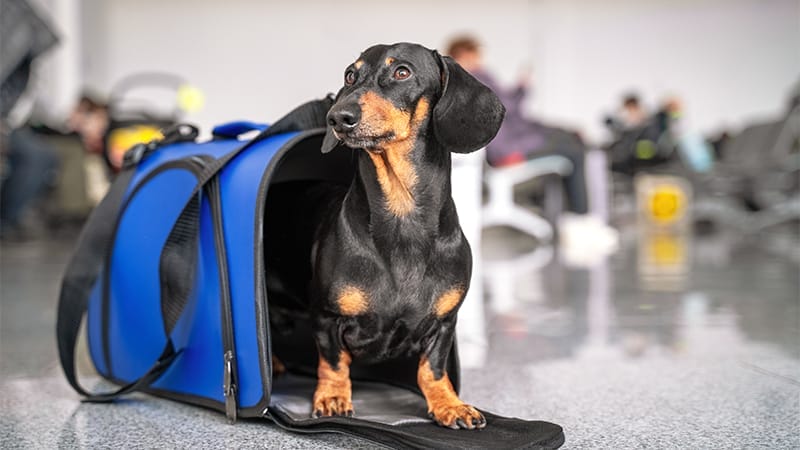
Tips for Safe Traveling with Pets by Car or Air
Traveling with pets? Plan a fun and safe trip with your pet using these helpful travel tips and guidelines.
Millions of Americans take trips each year, and many include their pets. To ensure a fun, anxiety-free journey with your furry family members, follow these tips from our MedVet Doctors for safe car or air travel.
Pre-Travel Veterinary Consultation
Before traveling with your pet, it’s important to consult with your veterinarian to ensure your pet is healthy enough for the trip. Depending on your travel mode and destination, you may need updated health records. Your veterinarian can also alert you to potential safety concerns, such as insects or wildlife, that you may encounter at your destination.
If you plan to fly with your pet, a pre-travel veterinarian visit is particularly important. Your veterinarian can recommend ways to keep your anxious pet relaxed during the flight. While medications like trazodone can be used to calm pets with anxiety, they are generally not advised for pets flying due to potential risks related to breathing and temperature regulation at high altitudes.
Keep in mind that as of 2024, dogs entering or re-entering the United States must meet specific health requirements:
- Be at least six months old
- Be microchipped
- Be vaccinated against rabies
For dogs receiving their first rabies vaccination, it must be administered at least 28 days before travel and after microchipping. Ensuring your pet meets these requirements will help prevent any issues during travel.

Tips for Traveling with Pets by Car
Driving allows flexible travel planning. Even if you have pets who enjoy a ride around town, you’ll want to take extra precautions for longer road trips.
- Ensure your pet has identification. Your pet should wear a collar with ID tags and be microchipped with current contact information.
- Take practice rides. This helps your pet get used to the car, and you can gradually extend your driving time with them.
- Use seatbelts or carriers for safety. Use a crash-tested crate, carrier, or pet seatbelt harness. Use them during the practice rides to acclimate your pet to the vehicle and crate or harness. While driving, always keep your pet in the back seat to avoid airbag danger.
- Schedule breaks. Stop every two to three hours for potty breaks, exercise, and water. Ensure your pet is on a leash or harness and walk in a safe area away from traffic. While it’s essential to keep your pet hydrated, consider feeding them a little less than normal to help prevent motion sickness or anxiety that can lead to gastrointestinal issues.
- Keep your pet inside the vehicle. Don’t allow your pet to put their head out of the window to prevent injury from debris or respiratory infections.
- Never leave your pet unattended. Even a few minutes in a parked car during warm or cold weather can be life-threatening. Be aware of the signs of heatstroke in dogs.
- Keep your pet busy and comfortable. Bring along your pet’s favorite toys or blankets, ensuring enough crate space to stand and turn around. A favorite toy can help alleviate anxiety, and items like puzzle toys can keep them occupied.

Tips for Traveling with Pets by Air
Check with your airline for specific pet travel requirements, including allowed animal types and sizes. Be aware that some airlines have limited space for pets in the cabin, so book early. For reference, a blog post from Chewy provides an overview of pet policies for major U.S. airlines.
You may need to obtain updated health records for your pet. Some airlines now accept digital pet passports or require digital health certificates through their online portals. Ensure you’re aware of the specific requirements for your airline.
Key tips for air travel with pets:
- Ensure your pet has identification. As mentioned above, pets should always have collars with ID tags and be microchipped for the best chance of reunification should they become lost. GPS pet collars are becoming more common and can add peace of mind.
- Consider purchasing pet travel insurance that includes coverage for delays, illnesses, or emergency care while traveling.
- Choose non-stop flights to minimize travel time and stress.
- Consider flight timing and temperature, avoid midday summer flights and peak travel seasons.
- For pets traveling in the cabin with you, check with your airline for specific carrier requirements. Some airlines have specific rules about pet size, breed, and health certificates.
- Use a USDA-approved crate for pets traveling in the cargo labeled “Live Animal” with your contact information; line it with towels or blankets and consider ice cubes for hydration.
- Inform airline staff about your pet (whether in cabin or cargo) and carry a current photo for emergencies.
- Examine your pet upon reunion and seek veterinary care if needed.
Finding Pet-Friendly Destinations
To ensure a smooth trip with your pet, research pet-friendly hotels, restaurants, and attractions ahead of time. Be sure to confirm the pet policies at your accommodations and review any rental agreements for specific rules or restrictions.
It’s also a good idea to prepare a list of nearby veterinarians or emergency pet hospitals, such as MedVet locations, in case your pet needs medical attention during your trip.
How to Pack When Traveling with Pets
To ensure a comfortable and stress-free trip for your pet, consider packing the following essential items:
- Comforts of Home: Bring your pet’s favorite toys and bed to provide a sense of familiarity in new environments. You may also want to pack sheets or blankets to protect the furniture at your destination.
- Food and Water: Maintain your pet’s regular diet to prevent gastrointestinal issues. Pack plenty of fresh water, their regular food, treats, and bowls to keep them hydrated and satisfied.
- Identification and Records: Verify that your pet’s ID tags and microchip information are up to date. Bring their health records, including vaccination documents, to ensure you’re prepared for any situation.
- Other Pet Care Items: Don’t forget to pack a leash, grooming supplies, medications, and waste disposal items. If you plan to engage in water activities, consider bringing a life vest for your pet.
By following these tips, you can ensure a fun and stress-free trip with your pet.
Visit our Pet Care Resources library for more pet health and safety information.
FAQs
Should my pet see a veterinarian before traveling?
What do I need to fly with my pet?
What are the essential items to pack for my pet when traveling?
Learn More
For ways to ensure your pet lives a happier, healthier life, visit our Pet Care Resources library.
Pet Care ResourcesContents
Learn More
For ways to ensure your pet lives a happier, healthier life, visit our Pet Care Resources library.
Pet Care Resources

